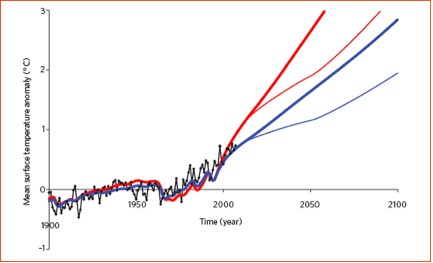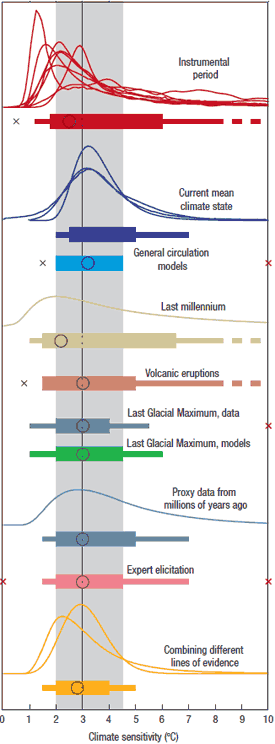Despite uncertainty, CO2 drives the climate
Posted on 18 October 2010 by dana1981
In August 2010, Nature published a commentary by Penner et al. which mainly focused on the uncertainty regarding the effect short-lived pollutants (such as aerosols and black carbon) have on the climate. As is often the case, many in the blogosphere misinterpreted and misunderstood the statements and conclusions in the commentary. Not surprisingly, the biggest misinterpretation related to the contribution of anthropogenic greenhouse gases to global warming. Below is the most misunderstood quote, in which I've emphasized the key word.
"Of the short-lived species, methane, tropospheric ozone and black carbon are key contributors to global warming, augmenting the radiative forcing of carbon dioxide by 65%. Others — such as sulphate, nitrate and organic aerosols — cause a negative radiative forcing, offsetting a fraction of the warming owing to carbon dioxide."
Numerous blogs have (mis)interpreted this statement to mean that carbon dioxide is only causing 35% as much global warming as previously believed. A more accurate reading of the quote is that certain short-lived pollutants cause warming in addition to carbon dioxide - quantitatively, approximately 65% as much warming as CO2. And certain other short-lived species cause a cooling effect which offsets some of this warming.
This is not a new conclusion. The IPCC puts the radiative forcing from CO2 at 1.66 W/m2, compared to the forcing from other greenhouse gases, black carbon, and tropospheric ozone at approximately 1.4 W/m2. Similarly, the negative forcing from aerosols is approximately -1.2 W/m2.

Figure 1: Radiative forcing estimates from the IPCC FAR
Thus if anything, the 65% figure is an underestimate of the contributions of short-lived pollutants to global warming, but this contribution does not change the 1.66 W/m2 radiative forcing from CO2 or the amount of global warming it has caused.
Much ado has also been made about another quote from the commentary:
"Warming over the past 100 years is consistent with high climate sensitivity to atmospheric carbon dioxide combined with a large cooling effect from short-lived aerosol pollutants, but it could equally be attributed to a low climate sensitivity coupled with a small effect from aerosols. These two possibilities lead to very different projections for future climate change."
This statement gets to the main point of the commentary - that there remains significant uncertainty regarding the effect of these short-lived pollutants on the global climate. However, estimates of the planetary climate sensitivity to increasing atmospheric CO2 and other radiative forcings are not solely based on the change in the mean global temperature over the past 100 years. In fact, the climate sensitivity parameter has been estimated through many different methods, including:
- climate models
- recent responses to large volcanic eruptions
- recent responses to solar cycles
paleoclimate data
- data from the last Glacial Maximum
- and yes, data from the instrumental period
Interestingly, Penner et al. find that whether the climate sensitivity parameter is on the low or high end, reducing anthropogenic emissions of the short-lived warming pollutants would achieve a significant reduction in global warming over the next 50-100 years. In the red lines in the Figure 3, they employ a climate model with a sensitivity of 5°C for 2xCO2, slightly outside the IPCC likely range. The blue line is a climate model with a sensitivity of 2°C for 2xCO2, on the lower end of the IPCC range. Note that even with the lower climate sensitivity, the model shows the planet warming 3°C by 2100 in this emissions scenario (see the figure caption for further details).

Figure 3: Global mean temperature measurements (black) and projections based on an IPCC scenario with high emissions (A2) for a climate sensitivity parameter of 5°C (upper red) and 2°C (upper blue). Linearly decreasing the total anthropogenic radiative forcing owing to methane, tropospheric ozone and black carbon — starting in 2010 and achieving pre-industrial levels by 2050 — results in significant near-term climate mitigation (lower blue and red curves) (Penner 2010)
Unfortunately, reducing the short-lived cooling pollutants such as aerosols would cause a warming effect of similar magnitude, and so CO2 remains the primary pollutant of concern. Coincidentally, a group of scientists from NASA GISS just published a paper in Science entitled Atmospheric CO2: Principal Control Knob Governing Earth's Temperature.
Although it is important to reduce the remaining climate uncertainties, such as the magnitude of the impacts of short-lived pollutants, it does not change the fact that CO2 is very likely the driving force behind the current global warming, or that if we double the amount of CO2 in the atmosphere from pre-industrial levels, the planet will likely warm in the range of 2 to 4.5°C.
This post is the Intermediate version (written by Dana Nuccitelli [dana1981]) of the skeptic argument "CO2 only causes 35% of global warming".































 Arguments
Arguments
























 0
0  0
0 From United States Energy Information Administration
Notice that population does not track coal consumption; your correlation is specious.
The swerve you see post-2002 continues; for 2008 production was 7,271,249 thousand short tons. There's lots more coal available, dirtier going forward, but plenty to burn unless we choose to do otherwise.
This business of changing the baseline seems simply an exercise in politically correct thinking.
From United States Energy Information Administration
Notice that population does not track coal consumption; your correlation is specious.
The swerve you see post-2002 continues; for 2008 production was 7,271,249 thousand short tons. There's lots more coal available, dirtier going forward, but plenty to burn unless we choose to do otherwise.
This business of changing the baseline seems simply an exercise in politically correct thinking.







Comments